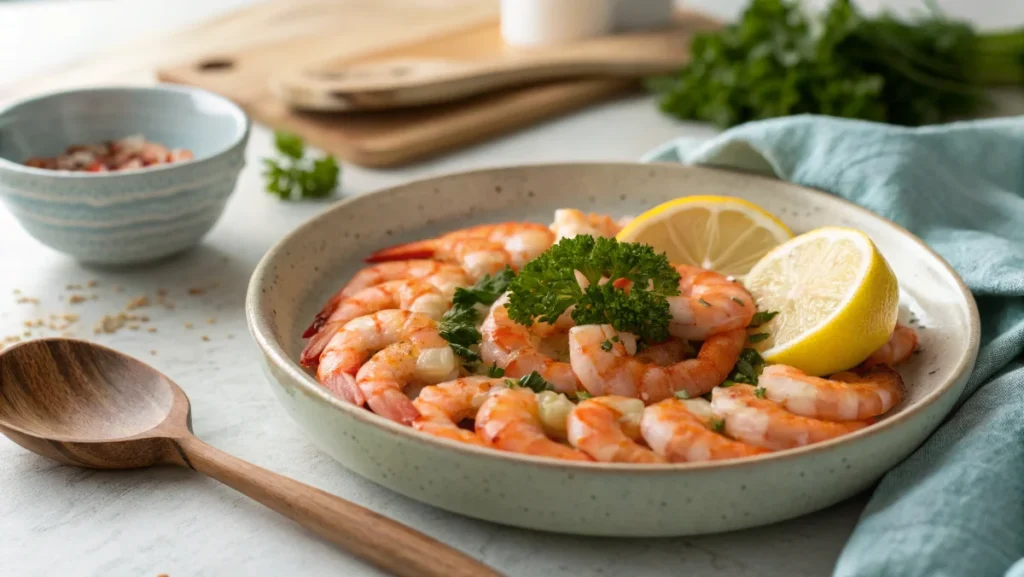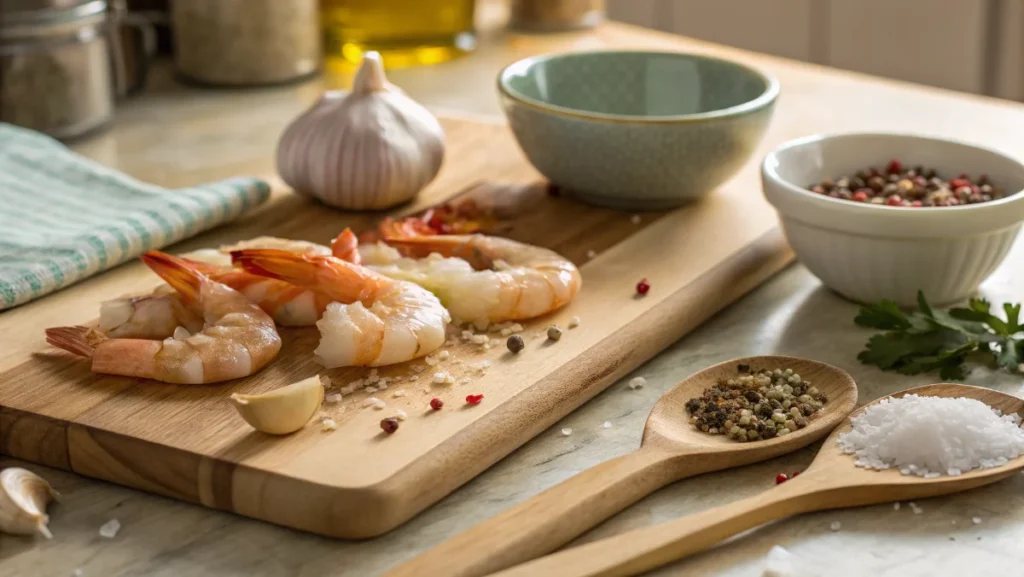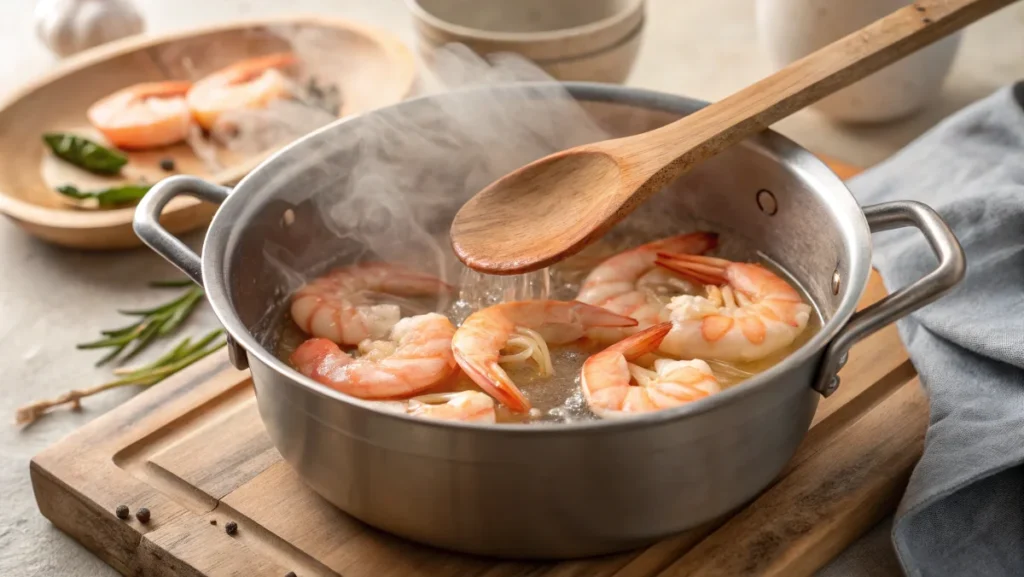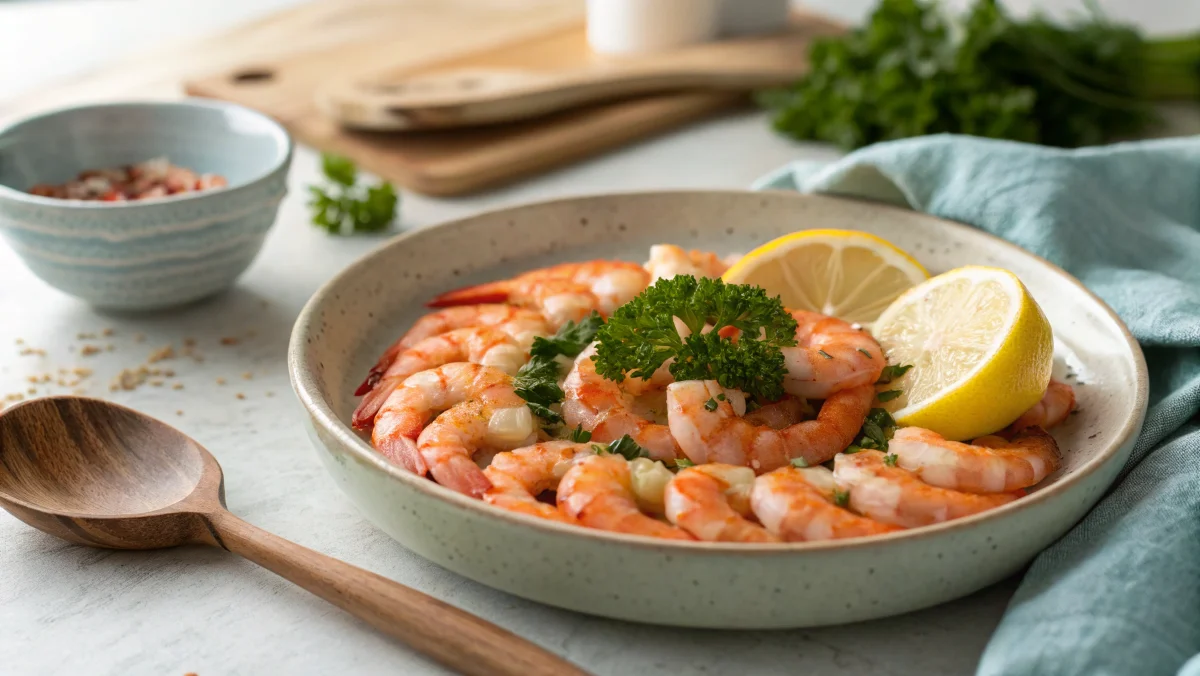How long to cook shrimp is a common question among home cooks and seafood lovers. Shrimp is a culinary favorite across the globe, admired for its sweet flavor and delicate texture. However, cooking shrimp can be a fine balancing act—overcooking leads to a tough, rubbery texture, while undercooking can result in unsafe food. Understanding the proper cooking time is crucial to achieving that perfect shrimp every time. When baking shrimp, it is common to wonder, Do you have to flip shrimp when baking? For a detailed explanation and tips, visit Do You Have to Flip Shrimp When Baking? A Quick Guide.

Table of Contents
Understanding Cooking Times for Raw Shrimp
Cooking shrimp is a quick process, typically taking only 3-5 minutes, depending on their size and the method used. The exact timing can also vary based on whether the shrimp are cooked with the shell on or peeled, and the chosen cooking technique. Shrimp can easily go from perfectly tender to overcooked in seconds, so precise timing is essential. Similarly, exploring other dishes like pizza can be equally rewarding. If you’re curious about toppings and combinations, learning What is a supreme pizza? can provide inspiration for your next culinary adventure.
Factors Affecting Shrimp Cooking Duration
Several factors influence how long it takes to cook shrimp. It’s essential to consider these before preparing your meal to avoid undercooking or overcooking.
1. Shrimp Size
- Large shrimp take longer to cook than smaller ones.
- Jumbo shrimp may require 5-6 minutes, while medium shrimp can cook in 3-4 minutes.
2. Cooking Method
- Boiling, grilling, and pan-searing all have different cooking times.
- Some methods, like grilling, require a slightly longer time compared to others.
3. Shrimp’s Temperature Before Cooking
- Frozen shrimp may require slightly more time than fresh shrimp, though thawing them first can help achieve optimal results.
4. Shell-on vs. Shell-off
- Shrimp in the shell tend to take a little longer to cook because the shell acts as an insulator.
Considering these variables helps you plan the cooking process more effectively and ensures your shrimp is cooked just right.
How to Identify Fresh Raw Shrimp Before Cooking
Before cooking raw shrimp, it’s vital to ensure that they are fresh. Fresh shrimp not only taste better but also provide a safer eating experience. Here’s how to identify fresh shrimp:
1. Smell
- Fresh shrimp should have a clean, slightly salty smell. Any sour or ammonia-like odor is a sign of spoilage.
2. Color
- The shell should be translucent or slightly gray. Avoid shrimp that looks discolored, as it can indicate age or poor handling.
3. Firmness
- Fresh shrimp should feel firm and resilient when touched. Soft or mushy shrimp are signs that they are not fresh.
4. Cleanliness
- Check the shrimp for any dirt or debris. Clean shrimp are a good indication of quality and care during processing.
Additionally, purchasing shrimp from a reputable source will help ensure that you are getting high-quality, fresh shrimp.
Prepping Raw Shrimp for Quick Cooking
Preparation plays a crucial role in ensuring that shrimp cooks quickly and evenly. Here are some simple steps to prep shrimp for cooking:
1. Thawing Frozen Shrimp
- If you’re using frozen shrimp, the best method is to thaw them in the refrigerator for several hours or overnight. However, if you’re in a hurry, you can place the shrimp in a bowl of cold water for 15-20 minutes.
2. Peeling and Deveining
- Many shrimp come pre-peeled and deveined, but if they don’t, you will need to remove the shells and the dark vein along the back of the shrimp. This will improve the flavor and texture of the cooked shrimp.
3. Rinsing Shrimp
- Rinse the shrimp under cold water to remove any remaining shell debris or excess salt.
By properly preparing shrimp, you not only ensure that it cooks evenly, but also maintain its delicate texture. Additionally, proper preparation helps to prevent the shrimp from becoming overcooked, therefore preserving its natural sweetness. In turn, this step contributes significantly to the overall quality of the dish. Moreover, ensuring that the shrimp is clean and properly thawed helps achieve the best possible results.

The Ideal Cooking Methods for Raw Shrimp
There are several methods for cooking raw shrimp, each providing different flavors and textures. The method you choose will affect how long it takes to cook shrimp, so it’s important to consider which one best suits your needs.
1. Boiling
- This is one of the fastest methods for cooking shrimp. Shrimp cooks quickly in boiling water, making it ideal for large batches.
2. Pan-Sautéing
- Pan-searing shrimp in a hot pan gives them a beautiful, golden color and adds flavor through caramelization.
3. Grilling
- Grilling shrimp infuses them with smoky flavors and offers a crispy exterior.
4. Baking
- Baking shrimp is a more hands-off method and is perfect for dishes like shrimp scampi.
Choosing the right method will help you control the texture and flavor, ensuring your shrimp is cooked to perfection.
How Long Does It Take to Cook Raw Shrimp in Boiling Water?
Boiling shrimp is one of the quickest ways to prepare them, and it works well for dishes like shrimp cocktails or adding shrimp to pasta. The cooking time is generally short, which helps to preserve the delicate flavor and texture.
Cooking Time
- For medium shrimp (about 31-40 per pound), it takes approximately 2-3 minutes to cook.
- For larger shrimp (16-20 per pound), expect them to take around 4-5 minutes.
The shrimp is done when it turns pink and opaque, and the flesh is firm. Overcooking will cause them to become rubbery, so keep an eye on them.
Steps for Boiling Shrimp
- Bring a pot of salted water to a boil.
- Add shrimp and stir occasionally.
- Once the shrimp turn pink and float to the top, they are done.
- Drain immediately and serve.
Boiling is a convenient option, but be mindful of the timing to ensure the shrimp doesn’t become tough.
Pan-Sautéing Raw Shrimp: Timing and Technique
Pan-sautéing is a quick and effective way to cook shrimp. This method provides a crispy, golden exterior while maintaining a juicy interior. The timing is crucial to prevent overcooking.
Cooking Time
- Medium shrimp typically cook in about 2-3 minutes per side.
- Larger shrimp may need 4-5 minutes per side.
Steps for Pan-Sautéing
- Heat a tablespoon of oil or butter in a skillet over medium-high heat.
- Add the shrimp and cook for 2-3 minutes, stirring occasionally.
- Once the shrimp turns pink and opaque, remove them from the pan immediately.
For best results, avoid overcrowding the pan. This ensures that each shrimp gets an even sear.
Steaming Raw Shrimp: How Long Does It Take?
Steaming shrimp is an excellent way to cook them gently while preserving moisture and flavor. Steamed shrimp is tender and juicy without becoming overcooked. This method is commonly used for serving shrimp as a main dish or adding them to salads.
Cooking Time
- Medium-sized shrimp typically take 4-5 minutes to steam.
- Larger shrimp may require an additional 2-3 minutes.
Steps for Steaming
- Fill a pot with water and bring it to a boil.
- Place the shrimp in a steaming basket or mesh strainer.
- Steam the shrimp for 4-6 minutes until they are opaque and pink.
Steaming is an excellent method for preserving the natural flavor and texture of shrimp, especially when paired with simple seasonings.
Grilling Raw Shrimp: Perfect Timing for Juicy Results
Grilling shrimp adds a smoky flavor that enhances their natural sweetness. While grilling requires a little more attention, the results are well worth the effort.
Cooking Time
- Medium shrimp typically take about 2-3 minutes per side.
- Larger shrimp can take 4-5 minutes per side.
Steps for Grilling Shrimp
- Preheat the grill to medium-high heat.
- Thread the shrimp onto skewers or use a grill basket.
- Grill the shrimp for 2-3 minutes per side, or until they turn pink and opaque.
Grilling shrimp creates a slightly crisp exterior while keeping the inside tender. Just be careful not to overcook them.

Baking Raw Shrimp: Timing Tips for Perfect Texture
Baking shrimp is an easy, hands-off method that produces tender, flavorful results. It’s especially useful when preparing shrimp for casseroles or other baked dishes.
Cooking Time
- Baking at 400°F typically takes 8-10 minutes for medium shrimp.
- Larger shrimp may require an additional 2-3 minutes.
Steps for Baking Shrimp
- Preheat your oven to 400°F (200°C).
- Place shrimp on a baking sheet, lightly seasoned with olive oil, garlic, and herbs.
- Bake for 8-10 minutes, or until they are pink and opaque.
Baking shrimp is ideal when you want minimal preparation and a consistent outcome.
Common Mistakes to Avoid When Cooking Raw Shrimp
Despite its simplicity, shrimp can be easily overcooked, leading to a rubbery texture. To avoid this, here are some common mistakes to watch out for:
1. Overcooking
- Shrimp cooks very quickly. Leaving them in the heat for too long can result in tough, chewy shrimp.
2. Not Monitoring the Temperature
- Shrimp cooks at a high temperature but not for long. Make sure you adjust the heat depending on the method.
3. Skipping Preparation Steps
- Rushing the prep, like failing to thaw shrimp properly or ignoring the deveining process, can affect both texture and taste.
4. Underseasoning
- Shrimp benefits from seasonings like garlic, lemon, and herbs, which enhance its natural flavors.
Avoiding these mistakes will help you achieve perfectly cooked shrimp every time.
How to Know When Raw Shrimp is Fully Cooked
The key to perfect shrimp lies in knowing when it is fully cooked. There are several ways to identify if shrimp is done:
1. Color Change
- When shrimp turns from translucent gray to an opaque pink color, it’s an indication that it is cooked.
2. Shape
- Shrimp should form a tight “C” shape when cooked. If the shrimp is curled tightly in an “O” shape, it is likely overcooked.
3. Texture
- The flesh should be firm to the touch, not mushy or rubbery.
By paying close attention to these signs, you can ensure that your shrimp is perfectly cooked.
FAQs:
1. How long does it take to fully cook raw shrimp?
The time it takes to fully cook raw shrimp depends on the cooking method, shrimp size, and whether it’s shelled or unshelled. On average, shrimp will take around 3-5 minutes to cook fully. For smaller shrimp, like medium-sized ones, cooking times are typically shorter, while larger shrimp may require a bit more time. It’s important to monitor the shrimp closely, as overcooking can lead to a rubbery texture. Shrimp is fully cooked when it turns pink, opaque, and forms a tight “C” shape.
2. How do you know when raw shrimp is cooked?
There are a few key indicators to tell when shrimp is cooked properly:
- Color Change: Raw shrimp is gray and translucent. When cooked, it should turn pink and opaque.
- Shape: Properly cooked shrimp will curl into a loose “C” shape. If they curl too tightly into an “O”, they may be overcooked.
- Texture: When you touch the shrimp, it should feel firm, not mushy or rubbery. If you press lightly, the shrimp should bounce back.
Use these visual and tactile cues to ensure your shrimp is cooked just right.
3. How long should you boil raw shrimp?
Boiling is one of the quickest methods to cook shrimp. Depending on the size of the shrimp, the boiling process should take about:
- 2-3 minutes for medium-sized shrimp (31-40 per pound)
- 4-5 minutes for large shrimp (16-20 per pound)
Once the shrimp turns pink and floats to the surface of the boiling water, it’s done. To avoid overcooking, promptly remove the shrimp from the water as soon as they are done.
4. How long to cook frozen raw shrimp?
When cooking frozen shrimp, the key is to thaw them first for more even cooking. If you’re cooking them straight from frozen, it may take 1-2 extra minutes compared to fresh shrimp. For methods like boiling, sautéing, or grilling:
- Boiling: 3-5 minutes
- Pan-Sautéing: 4-6 minutes per side
- Grilling: 4-6 minutes per side
For best results, it’s recommended to thaw frozen shrimp in the refrigerator overnight or place them in a bowl of cold water for 15-20 minutes before cooking.
Conclusion: Mastering How Long to Cook Shrimp for Perfect Results
In conclusion, knowing how long it takes to cook raw shrimp is key to a delicious dish. Boiling, sautéing, grilling, and baking offer different textures and flavors, but it’s crucial to avoid overcooking, as shrimp cooks quickly and can become rubbery. Proper preparation and the right cooking methods ensure perfectly cooked shrimp. For more culinary inspiration, check out Maki Sushi: Types, Ingredients, Popular Recipes & Health Benefits.

